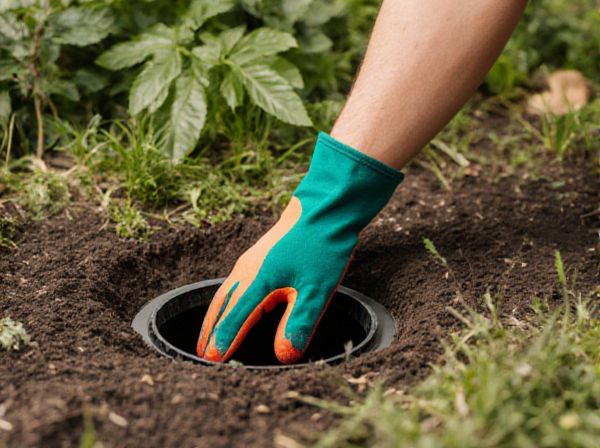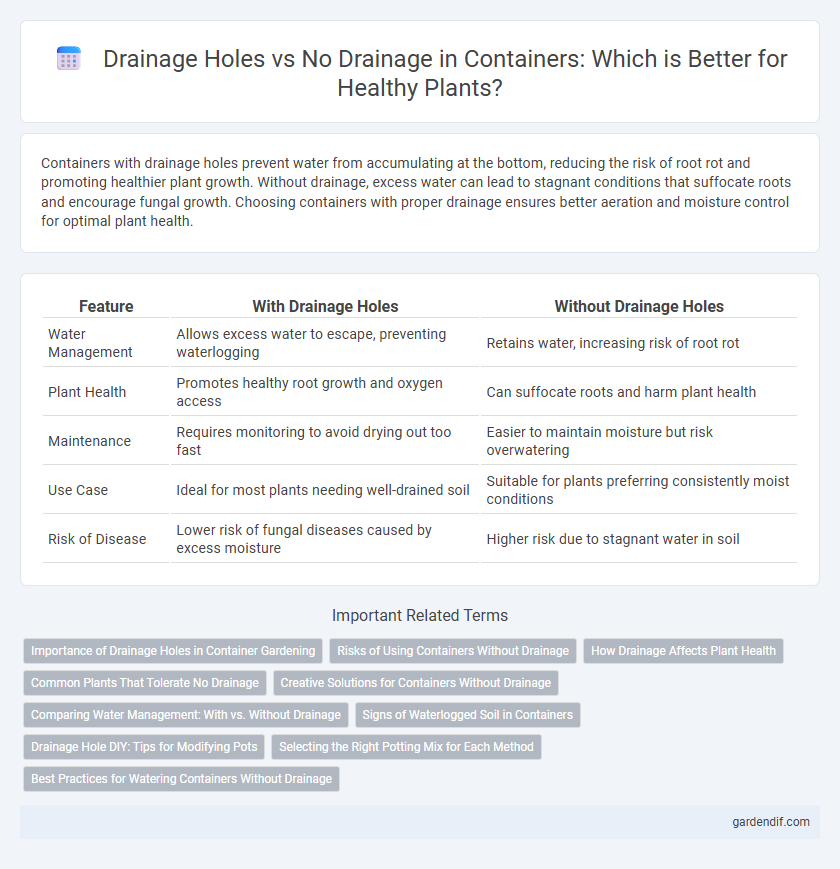
Drainage holes vs no drainage Illustration
Containers with drainage holes prevent water from accumulating at the bottom, reducing the risk of root rot and promoting healthier plant growth. Without drainage, excess water can lead to stagnant conditions that suffocate roots and encourage fungal growth. Choosing containers with proper drainage ensures better aeration and moisture control for optimal plant health.
Table of Comparison
| Feature | With Drainage Holes | Without Drainage Holes |
|---|---|---|
| Water Management | Allows excess water to escape, preventing waterlogging | Retains water, increasing risk of root rot |
| Plant Health | Promotes healthy root growth and oxygen access | Can suffocate roots and harm plant health |
| Maintenance | Requires monitoring to avoid drying out too fast | Easier to maintain moisture but risk overwatering |
| Use Case | Ideal for most plants needing well-drained soil | Suitable for plants preferring consistently moist conditions |
| Risk of Disease | Lower risk of fungal diseases caused by excess moisture | Higher risk due to stagnant water in soil |
Importance of Drainage Holes in Container Gardening
Drainage holes are essential in container gardening to prevent waterlogging and root rot by allowing excess water to escape, ensuring optimal oxygen flow to plant roots. Containers without drainage holes increase the risk of stagnant water, which can suffocate roots and promote fungal diseases, ultimately harming plant health. Proper drainage promotes healthier root systems and improves nutrient uptake, leading to more vigorous and thriving plants.
Risks of Using Containers Without Drainage
Containers without drainage holes pose significant risks such as waterlogging, which leads to root rot and fungal infections. Excess moisture accumulation deprives roots of oxygen, impairing plant growth and causing wilting or death. Proper drainage is essential to maintain soil aeration and prevent the buildup of harmful pathogens.
How Drainage Affects Plant Health
Drainage holes significantly improve plant health by preventing water from accumulating at the bottom of containers, which reduces the risk of root rot and fungal infections. Proper drainage ensures excess water escapes, promoting healthy oxygen flow to roots and encouraging robust root development. Containers without drainage holes can cause waterlogging, leading to suffocation of roots and poor nutrient absorption, ultimately stunting plant growth.
Common Plants That Tolerate No Drainage
Succulents, snake plants, and ZZ plants are common container plants that tolerate no drainage due to their low water requirements and ability to withstand occasional overwatering. These plants thrive in containers without drainage holes by utilizing well-draining soil mixes that prevent root rot and promote healthy growth. Choosing species adapted to dry conditions ensures longevity and ease of maintenance in nondraining containers.
Creative Solutions for Containers Without Drainage
Containers without drainage holes require innovative solutions to prevent waterlogging and root rot. Using a layer of pebbles or activated charcoal at the bottom improves aeration and absorbs excess moisture, while self-watering systems with wicks regulate hydration efficiently. Leveraging moisture-retentive soil mixes and careful watering schedules supports healthy root development despite the lack of drainage.
Comparing Water Management: With vs. Without Drainage
Containers with drainage holes offer superior water management by allowing excess water to escape, preventing root rot and promoting healthy plant growth. In contrast, containers without drainage trap water, increasing the risk of overwatering and suffocating plant roots. Effective drainage enhances aeration and nutrient uptake, which are critical for sustaining plant vitality.
Signs of Waterlogged Soil in Containers
Waterlogged soil in containers manifests through persistent surface moisture, slow soil drying, and a foul odor indicating poor aeration. Leaves may yellow and roots turn mushy or black due to lack of oxygen from excessive water retention. Containers without drainage holes are more prone to these issues, causing root rot and plant decline.
Drainage Hole DIY: Tips for Modifying Pots
Draining holes are critical for preventing waterlogged soil and root rot in container plants, ensuring aeration and healthy root development. When modifying pots without drainage, create holes using a drill with a ceramic bit or a heated nail to avoid cracking, and place a mesh or coffee filter over holes to prevent soil loss. Adding a layer of gravel or broken pottery at the bottom further improves drainage efficiency, promoting optimal plant growth.
Selecting the Right Potting Mix for Each Method
Selecting the right potting mix depends on whether the container has drainage holes; pots with drainage require well-draining mixes like those containing perlite, sand, or bark to prevent waterlogging and root rot. Containers without drainage need moisture-retentive yet aerated mixes, often incorporating materials such as coco coir or sphagnum moss to balance water retention and airflow. Matching the potting mix to the container's drainage type optimizes root health and supports plant growth effectively.
Best Practices for Watering Containers Without Drainage
Watering containers without drainage holes requires careful attention to avoid waterlogging and root rot in plants. Using a layer of coarse material such as gravel at the bottom helps create an air gap and improves water retention control. Monitoring soil moisture frequently and watering sparingly ensures optimal hydration while preventing excess water accumulation in non-draining containers.
Drainage holes vs no drainage Infographic

 gardendif.com
gardendif.com